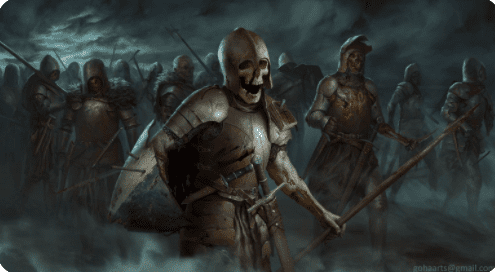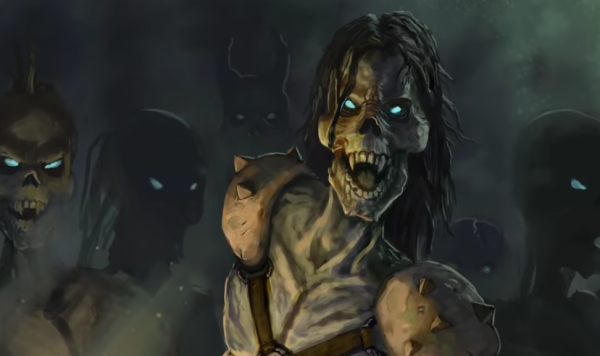No matter your reasons for healing your undead minions, this guide has got you covered! I will try to answer everything there is to know about healing undead 5e in Dungeons and Dragons. If you still have questions after reading this article, just submit a comment, and I will try to answer you as fast as possible.
This article will begin by talking about what an undead is in DnD with a couple of examples, so you have a clear idea. Then I will discuss a ton of ways how you can and can’t heal undead monsters in 5e. Finally, I am going to give you a bunch of great tips that you will definitely find helpful, no matter if you enjoy being a player or a DM.
What are undead in DnD?
The undead is creatures and humans that were once normal living beings. However, due to a spiritual or magical force, they have been brought back from the dead. They do not have any Life Force, but they have negative energy. This is still some kind of energy, and the opposite of the god give positive natural Life Force.
Loyal to their master
The undead is mainly known for being absolutely loyal to he who has reanimated them. Another aspect they are known for is how resilient they are against an extensive range of status effects. You won’t be able to poison, stun, paralyze,… an undead. This often makes them an annoying foe to deal with.
Wide range of power and intellect
Now, this is the general description of the undead in Dungeons and Dragons. If you have played the game, you surely know that there are many undead creatures and that they are very different from one another. For example, you have the intelligent living dead like the wight and the ghoul who can have their own motivations.
Then you also have the classic skeleton, which for the most part, has faulty intelligence. You also have the complete other side of the spectrum; undead like liches who are often brilliant and rational actors who can plan, strategize, and plot.

If you are a DM and looking for a good creature for your next campaign that is part of the living dead, you have tens of unique and obscure monsters to choose from. An excellent example of a pretty unknown undead is an Attic Whisperer. This is one of my favorites for creepy campaigns.
The difference with Constructs
If you are new to DnD, you should know the difference between an undead monster and a construct. A construct like an Ice Elemental is not an undead being. Living dead have been alive at one point. A construct has never been more than just matter. A Golem has been made out of the dirt. A skeleton has been made out of the bones of something that has perished.
This difference between the two creature types matters because the rules for the spells can be different. For example, if you summon a Planar Ally, a construct, you won’t be able to repair them in the same way you heal undead in 5e. So again, you will need to check out the rules of the spells if they explicitly say they do not work on constructs.
Does Feign Death 5e have any relevance here
When you are thinking about scenarios related to healing undead 5e, there are often players that bring up Feign Death. To be clear, while this spell makes you indistinguishable from a regular dead creature. It does not turn you into an undead, nor does it give someone the illusion that you are one. Keep this in mind, as there are always players who for some reason think this turns them into an undead for the duration of the spell.
So no, illusion spells or other spells that make it seem like you are no longer alive do not have any relevance if we are talking about repairing or restoring the hit points.
How healing undead 5e is different compared to 4e
If you have played the previous editions of Dungeons and Dragons, you likely are aware that a ton of things have changed, for better or worse, in 5e. One of those things is how undead can (not) be healed. This guide is going to tell you all there is to know about this.
Healing Undead in Previous Editions
You could heal your undead minions in previous editions by casting a spell on them that did necrotic damage. E.g., when you would release the magic to inflict wounds on an undead, the damage customarily dealt would be added to the creature’s hit points instead of subtracted. On the other hand, you could damage an undead by casting spells that heal living beings, like close wounds and other radiant attacks.
Healing Undead in 5e
You can use a regular healing spell if you want to heal or repair your undead creatures in 5e. However, you need to read the description of your healing spell very carefully. The vast majority of the cure and heal magic states that it does not work on undead creatures.
Examples
An excellent example of this would be Heal Hands. This spell explicitly states that it does not work on undead and constructs. However, a couple of powerful healing spells like Life Transference work on the undead. Another spell that works on the undead is regeneration 5e. The magic does not say it has no effect, so you can assume it heals those monsters just like they would heal any other creature.
Does healing hurt dead in 5e?
Some spells say they do not heal undead. The next logical question then would be, do they still hurt the undead as they did in the 4e and 3e?
The answer is again; you need to read the spell to find out if the healing charm hurts undead. If it says it does, it will hurt them. If the magic says nothing about damage to a type of creature, then it will not deal damage or break it.
When in doubt, always read the spell’s description, the item, the creature, and so on. In 5e, the golden rule is that it is allowed if it is not in the rules. However, as a Dungeon Master and as a player, you are responsible for not making your campaign spin out of control. Keep using common sense, and your campaign will be fine.
Does long and short rests or sleep heal an undead?
Undead do not need to sleep or eat, but what if they do? Does that have any positive effects on them like a regular living creature? Is there a difference amongst undead in this regard, or do they all have the same (or no) effect?
DM ruling
Well, there isn’t a rule in 5e that sleeping or eating heals undead. So, in the end, it is up to your Dungeon Master to rule on this matter. In my campaigns, low-tier creatures like skeletons do not get any benefit from getting a short or long rest. However, I do give creatures and players that play as high-level intelligent undead the same benefits from sleeping.
How I do it as a DM
In practice, it comes down to the following. If one of my players is playing as a lich or a necromancer that thrives on negative energy, I give them the ability to rest and have the same effects as a normal creature would. I just say they are meditating and are absorbing the negative energy of things naturally decaying. That is the great thing about fantasy; your crazy explanations and rule-bending can be whatever you want it to be.
If my player has some undead minions, like a skeleton, then these do not get any benefit from sleeping. So, to somewhat counter this (major) disadvantage of not being able to heal, the undead of the lower tier does not get exhausted in my campaigns.
Note: There are some, like the Ghouls and Ghasts, that do need to eat, but it doesn’t nourish them.
Do healing potions work on undead 5e?
Ineffectiveness of Healing Magic
In the fifth edition, such magic like healing words, Cure wounds, etc., is ineffective at healing undead. Why? Because the spells literally say so. The ground rule in 5e is, things do what they say they do and don’t do what they say they do not do. The magic spell Goodberry does not say it does not work on that type of creature, so it does work. It really is not that hard.
Logic of Healing Potions
So taking this logic to healing potions and applying it to the question of whether they affect the undead in 5e gives us the answer: Yes, healing potions work on undead creatures. The only reason why they would not work is if they would say they don’t.
Homebrewing and Immersion
Of course, nobody is stopping you from HomeBrewing a little. It is kind of weird to see a skeleton downing a healing potion and all of a sudden get restored to total health. In my campaign, I either make my players use a special kind of potion or only give them a fractional effect of the power of the brew.
Alternative Application
Another way is to not make them drink the potion but just apply it to the bones and rotting flesh. This is just a minor immersion detail, so I would not get hung up about it.

Does necrotic damage still heal undead in 5e
No, necrotic damage no longer heals undead monsters when you cast it on them. The only exception will be if the spell specifically says it does or if the monster has some kind of exceptional ability. However, in almost every single case – HomeBrew excluded – it does not heal a monster like a zombie, skeleton, lich, or mummy.
Necrotic damage can actually damage this creature type now. Once again, you will need to look at the spell and the creature’s immunities. A lot of undead have immunity against necrotic damage, so they won’t be damaged by a spell-like Finger of Death or Chill Touch when it is cast on them.
Healing undead 5e versus previous editions of DnD
5e has changed a lot of rules and restoring the hit points of zombies, skeletons, and other creatures like them is amongst those drastically changed rules. In the past, healing an undead was pretty complex before 5e. One of the ways to do this was by using a spell that did necrotic damage on them. In the 3rd edition, this was one of the most effective ways of repairing your minions. However, if you cast a type of magical sorcery like cure wounds on them, you would actually hurt them.
Does necrotic damage hurt undead 5e
As mentioned above, this is entirely dependent on 1. What the spell says it does, and 2—the immunities of the creature. So, for example, if the description of the magic says it does not have any effect on the undead, it will not do damage.
Moreover, it is possible that the undead is immune to necrotic damage and will not be hurt by it. You will need to check the immunities (or resistances) of the monster to be sure.
In short, necrotic damage is no longer helpful in healing undead and can actually damage them in 5e depending on the spell and immunities of the target. Necrotic damage also has no effect when the monster has 0 hit points, so you can not revive your creatures using this spell.
Radiant damage to undead in 5e DnD
The damage of Radiant VS Undead in DnD has been around for ages, but does it remain the same in 5e? I have to disappoint you, but radiant damage is not exceptionally extra effective against an undead.
Radiant damage is not the same as fire damage. Radiant damage in 5e comes from a divine source like the magic of a Cleric. That means it has this extra bonus, which can cause a higher amount of damage if the target has a weakness to holy magic. A good example of radiant damage would be a guiding bolt cast by a cleric.
Once again, it comes down to the description in the rulebook and if the monster, for example, a skeleton or a vampire, has a weakness against radiant damage. In most cases, an undead will not take extra damage from radiant based spells. There are a couple of exceptions like always, but nothing too interesting.

What about reviving and resurrecting the undead
Yes, you can revive or resurrect an undead in 5e. This does not change their status or make them extra undead. However, the success of this will depend on the spell you use. Some attacks, like regular, resurrect, explicitly state that they do not have an effect on the undead. So casting it would be futile.
Good undead spells
There are a couple of spells that will bring back the undead to euh… life? The three most exciting spells to resurrect them in 5e are Raise Undead, True Resurrection, and Revivify. All three of these spells do not state they do not work on a particular class or creature type. As we have discussed here quite extensively, that means that they do work on the undead monsters you want to bring back from the super-dead.
Homebrew
There are a ton of other spells in HomeBrew that are effective at bringing creatures back from the dead. As a Dungeon Master, I highly recommend you to read up on Homebrew spells to make your campaign more captivating.
No matter if you are a player or a dungeon master, knowing if healing the undead works in 5e is beneficial. Tonnes of campaigns feature a zombie, skeleton, or other living dead monsters. Maybe you also want to know this since you as a player are playing as a HomeBrew lich or skeleton class character.

Conclusion: how healing undead 5e works
There are a ton of ways to get your undead allies back in the fight. Surprisingly, a lot of ways to heal them are just precisely the same as living creatures. For example, you can use your potions to recover them.
For player characters, you can give a short and long rest a similar effect on higher-level intelligent undead. That way, they do not have the (primary) disadvantage of not being able to be rested and healed. For lesser undead, I make sure they can not get exhausted as a way to even things out.
In 5e, it is essential to remember that the rules explicitly state what spells can not do. If the attack does not say it does not work on an undead monster, a construct, a dragon, and so on, it works. The opposite is also true; of course, if it says it does not work on a creature type, the spell won’t work on them.
Are you interested in learning more about creatures in Dungeons and Dragons for your next campaign? Then I am sure the Helmed Horrors are going to spice things up! Did you know these inanimate armors can fly? Interesting facts like that and much more nerd knowledge are waiting for you to be read and discovered!
| Topic | Information |
|---|---|
| Healing Undead with Necrotic Damage | – Necrotic damage no longer heals undead monsters in 5e unless specified in the spell or the monster has an exceptional ability. |
| – Undead creatures like zombies, skeletons, liches, or mummies are typically not healed by necrotic damage spells. | |
| Damaging Undead with Necrotic Damage | – Undead creatures may be damaged by necrotic damage spells depending on the spell and the creature’s immunities. |
| – Many undead have immunity to necrotic damage, making them unaffected by spells like Finger of Death or Chill Touch. | |
| Healing Undead in 5e vs Previous Editions | – In previous editions, healing undead was complex, often involving spells that dealt necrotic damage. |
| – Casting healing spells like cure wounds on undead would harm them in previous editions. | |
| – 5e has changed the rules for restoring hit points to undead creatures, making previous methods ineffective. | |
| Effectiveness of Necrotic Damage on Undead in 5e | – The effect of necrotic damage on undead in 5e depends on the spell’s description and the immunities of the undead creature. |
| – If the spell explicitly states it has no effect on undead, it will not damage them. | |
| – Undead creatures may also be immune to necrotic damage, which means they will not be harmed by such spells. | |
| – Necrotic damage has no effect on an undead creature with 0 hit points and cannot be used to revive them. | |
| Radiant Damage to Undead in 5e | – Radiant damage is not exceptionally effective against undead in 5e. |
| – Radiant damage comes from a divine source, such as a Cleric’s magic, and may cause additional damage if the undead has a weakness to holy magic. | |
| – The effectiveness of radiant damage against undead depends on the description in the rulebook and the specific weaknesses or resistances of the undead creature. | |
| – In most cases, undead creatures do not take extra damage from radiant-based spells. | |
| – Exceptions may exist, but they are not significant or noteworthy. |
